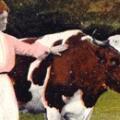 PRESERVING MEAT
PRESERVING MEAT
During the summer, two or three experienced men, with the help of the women and children, could slaughter and dress a dozen hogs in a single day. Once a hog was killed, it was hung to bleed. The hair and bristle would then be removed by pouring hot water over the carcass. This would loosen the hair and bristle, which could then be scraped off. The carcass was then cut up into hams, forelegs, and various other pieces, which were then placed in barrels filled with strong salt brine.
The women would melt the fat into lard. The liver was cooked and made into liverwurst, and headcheese was prepared after soaking the head and feet. The meat was then chopped up very fine and stored in jars.
Sausage making was another process completed the same day. Sausages were made of chopped, flavoured meat. Cotton bags served as casing to hold the meat, the early sausages being more like meat cakes than the sausages we know today.
Sometimes an old cow, which was no longer producing milk, would be killed around Christmas time. It would be cut up, laid on the verandah, and left until frozen solid. It would then be wrapped up and buried in the oat bin, which made an excellent deep freeze.
THE SMOKE HOUSE
Many settlers built their own smoke houses to enable them to cure their own meat in the spring. Hams, bacon, and beef, which had been salted down, would be removed from the brine, washed, and then hung in the smoke house, which was usually built of wood. The walls of the smoke house were covered with grease. The best smudge for smoking was obtained from burning beech, birch, hickory, maple, or corncobs.
Sometimes meat was smoked for only a few days, but sometimes it was kept in the smoke house for six weeks or more. The hams, which were sewn into cotton bags, would keep for months, even during the summer.
In later years, many farmers had improved smoke houses built of brick or stone.